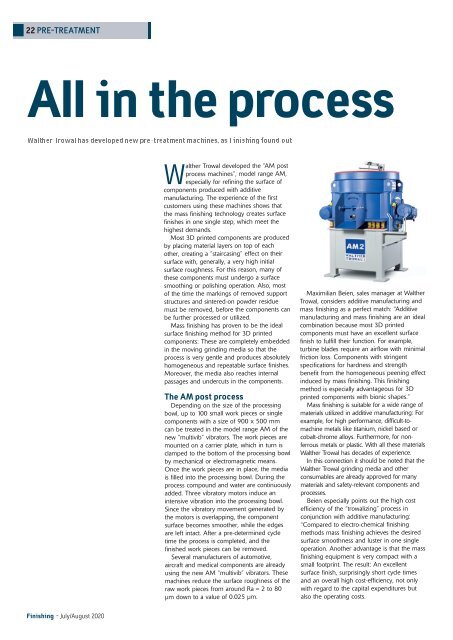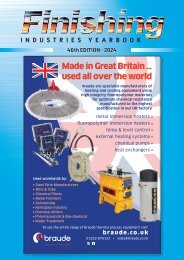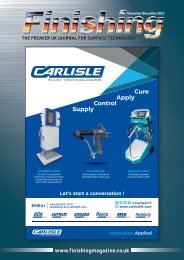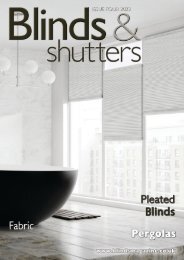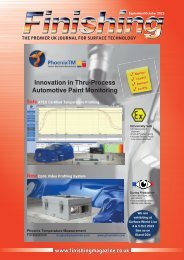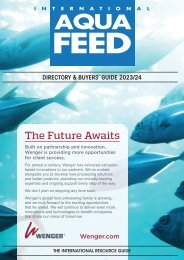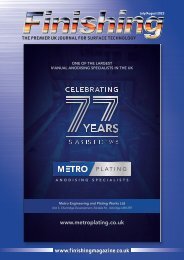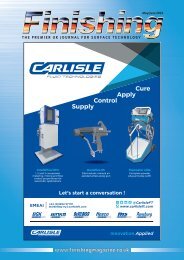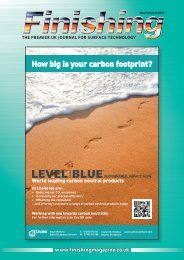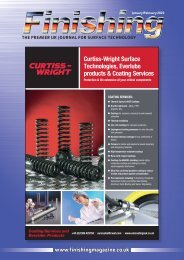Finishing - July-August 2020
Create successful ePaper yourself
Turn your PDF publications into a flip-book with our unique Google optimized e-Paper software.
22 PRE-TREATMENT<br />
All in the process<br />
Walther Trowal developed the “AM post<br />
process machines”, model range AM,<br />
especially for refining the surface of<br />
components produced with additive<br />
manufacturing. The experience of the first<br />
customers using these machines shows that<br />
the mass finishing technology creates surface<br />
finishes in one single step, which meet the<br />
highest demands.<br />
Most 3D printed components are produced<br />
by placing material layers on top of each<br />
other, creating a “staircasing” effect on their<br />
surface with, generally, a very high initial<br />
surface roughness. For this reason, many of<br />
these components must undergo a surface<br />
smoothing or polishing operation. Also, most<br />
of the time the markings of removed support<br />
structures and sintered-on powder residue<br />
must be removed, before the components can<br />
be further processed or utilized.<br />
Mass finishing has proven to be the ideal<br />
surface finishing method for 3D printed<br />
components: These are completely embedded<br />
in the moving grinding media so that the<br />
process is very gentle and produces absolutely<br />
homogeneous and repeatable surface finishes.<br />
Moreover, the media also reaches internal<br />
passages and undercuts in the components.<br />
The AM post process<br />
Depending on the size of the processing<br />
bowl, up to 100 small work pieces or single<br />
components with a size of 900 x 500 mm<br />
can be treated in the model range AM of the<br />
new “multivib” vibrators. The work pieces are<br />
mounted on a carrier plate, which in turn is<br />
clamped to the bottom of the processing bowl<br />
by mechanical or electromagnetic means.<br />
Once the work pieces are in place, the media<br />
is filled into the processing bowl. During the<br />
process compound and water are continuously<br />
added. Three vibratory motors induce an<br />
intensive vibration into the processing bowl.<br />
Since the vibratory movement generated by<br />
the motors is overlapping, the component<br />
surface becomes smoother, while the edges<br />
are left intact. After a pre-determined cycle<br />
time the process is completed, and the<br />
finished work pieces can be removed.<br />
Several manufacturers of automotive,<br />
aircraft and medical components are already<br />
using the new AM “multivib” vibrators. These<br />
machines reduce the surface roughness of the<br />
raw work pieces from around Ra = 2 to 80<br />
µm down to a value of 0.025 µm.<br />
Maximilian Beien, sales manager at Walther<br />
Trowal, considers additive manufacturing and<br />
mass finishing as a perfect match: “Additive<br />
manufacturing and mass finishing are an ideal<br />
combination because most 3D printed<br />
components must have an excellent surface<br />
finish to fulfill their function. For example,<br />
turbine blades require an airflow with minimal<br />
friction loss. Components with stringent<br />
specifications for hardness and strength<br />
benefit from the homogeneous peening effect<br />
induced by mass finishing. This finishing<br />
method is especially advantageous for 3D<br />
printed components with bionic shapes.”<br />
Mass finishing is suitable for a wide range of<br />
materials utilized in additive manufacturing: For<br />
example, for high performance, difficult-tomachine<br />
metals like titanium, nickel based or<br />
cobalt-chrome alloys. Furthermore, for nonferrous<br />
metals or plastic. With all these materials<br />
Walther Trowal has decades of experience.<br />
In this connection it should be noted that the<br />
Walther Trowal grinding media and other<br />
consumables are already approved for many<br />
materials and safety-relevant components and<br />
processes.<br />
Beien especially points out the high cost<br />
efficiency of the “trowalizing” process in<br />
conjunction with additive manufacturing:<br />
“Compared to electro-chemical finishing<br />
methods mass finishing achieves the desired<br />
surface smoothness and luster in one single<br />
operation. Another advantage is that the mass<br />
finishing equipment is very compact with a<br />
small footprint. The result: An excellent<br />
surface finish, surprisingly short cycle times<br />
and an overall high cost-efficiency, not only<br />
with regard to the capital expenditures but<br />
also the operating costs.<br />
<strong>Finishing</strong> - <strong>July</strong>/<strong>August</strong> <strong>2020</strong>


